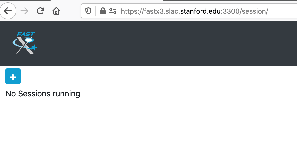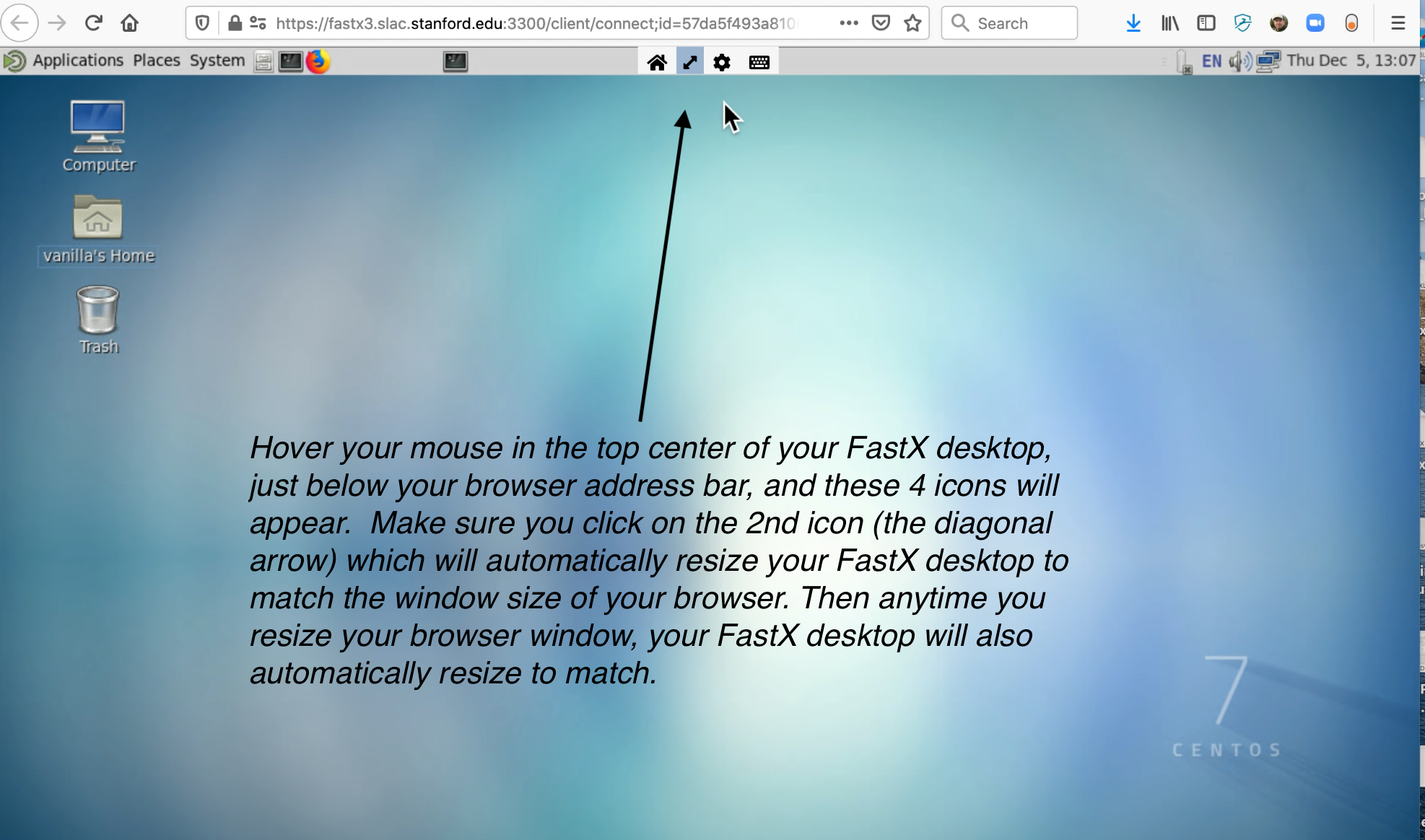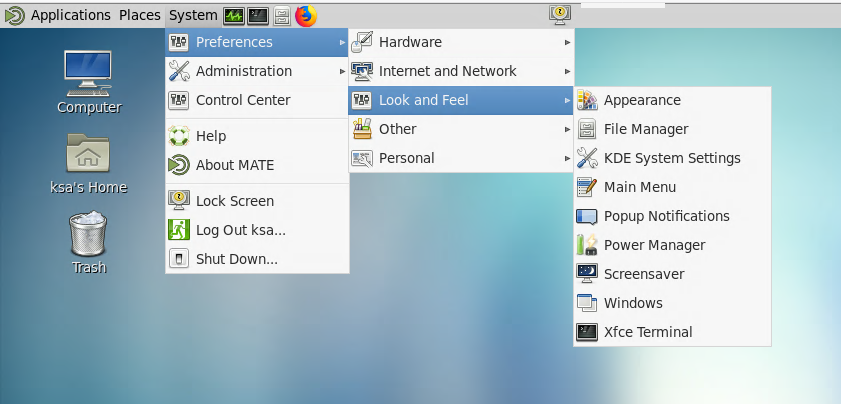Table of Contents:
| Table of Contents |
|---|
...
Quick Start
Open your web browser, go to the following URL, authenticate using your SLAC Unix username and password, select either 'Desktop' or 'Terminal'.
...
https://fastx3.slac.stanford.edu:33003443
Introduction
FastX is a modern solution for displaying high resolution Linux GUI applications securely over LAN or WAN connections.
Additional information can be found on the StarNet web page: https://www.starnet.com/fastx/ .
FastX version 3 provides SLAC Linux desktop and/or GNOME terminal in your web browser. It has many improvements over FastX version 2.
Local home directory on fastx3 is for local/temporary files only
The local /home directory on fastx3 is for temporary files only.
Data should be stored on AFS, GPFS, NFS, or other networked filesystems.
Email unix-admin@slac.stanford.edu if you need assistance or have questions.
Your quota for the local /home on fastx3 can be seen with the command: quota -s
Usage
The FastX server includes built-in browser access, and this is the recommended way to access FastX. The desktop client is optional.
| Reasons to use the built-in web browser | Reasons to use the optional desktop client |
|---|---|
| No need to download and install an additional application | More seamless integration with your desktop or laptop |
| No need to routinely check for upgraded versions of the desktop client | A remote terminal acts like any other local desktop application |
| Easier re-connections to existing or dropped sessions | A remote SLAC Linux Desktop can be view in full-screen mode |
| If the fonts or display using the desktop client are not adequate | If the fonts or display using the web browser are not adequate |
| Built-in web browser access to FastX is available here: https://fastx3.slac.stanford.edu: |
| 3443 | The optional desktop client (version 3 required) can be downloaded here: https://www.starnet.com/download/fastx-client |
If you have an older version (eg, version 2) of the desktop client already downloaded, this will not work with version 3 of the FastX server – please download the latest version 3 of the client.
If the quality of the display (resolution, fonts, etc.) does not look good on a web browser, try an alternative browser (eg, Chrome, Firefox). If it still does not look good, try the optional desktop client (version 3).
...
- Open any web broswer (firefox, chrome, etc.)
- Enter this URL: https://fastx3.slac.stanford.edu:33003443
- The first time you log in, you will see the standard login banner:
- After you click "Accept", you will see a login screen that looks like this:
- Enter your SLAC Unix username and password.
- If this is the first time you are logging in, you won't have any sessions running yet. You'll see a screen that looks like this:
- Click on the blue + (plus) icon you see above. You'll have the choice to choose between two default bookmarks:
- If you click on "Desktop", you will get a full Linux Desktop. If you click on "Terminal", you will get a single Linux gnome terminal. In both cases, these will be running on the fastx3 server. Feel free to run any applications you want on fastx3, but you will likely want to ssh to another SLAC machine to run programs. Your home directory on the fastx3 server is local and empty on purpose – so you have a new, clean environment which allows the desktop and gnome-terminal applications to work properly (using old dot files from your AFS home directory can use display issues with newer versions of gnome applications).
- When you are running the "Desktop" application in your web browser, there is one useful setting to be aware of. See this screenshot:
The text in this screenshot says: "Hover your mouse in the top center of your FastX desktop, just below your browser address bar, and these 4 icons will appear. Make sure you click on the 2nd icon (the diagonal arrow) which will automatically resize your FastX desktop to match the window size of your browser. Then anytime you resize your browser window, your FastX desktop will also automatically resize to match.
Step by Step Instructions For Using the Optional Desktop Client
...
- Download the latest version 3 of the desktop client here:
https://www.starnet.com/download/fastx-client- As of 2020-AprNov-52, the latest version for MacOS and Windows is Build 3.01.40 22 released on Feb 18Sep 22, 2020.
- Click on "About FastX" from the menu bar in your FastX desktop client to view your version.
- Check back every so often to see if there is an updated version of the desktop client (eg, for bug fixes). The release notes are here:
https://www.starnet.com/xwin32kb/fastx-3-desktop-client-release-notes/ - When you start the desktop client for the first time, there will not be any connections configured yet. The first step is to configure a new connection to fastx3.slac.stanford.edu:3300
- click on the + (plus) icon to add a new connection
- you can choose "Web" or "SSH". either should work fine, you can try both to see which one works better for you.
- one consideration is if your home network (or remote network wherever you are located) has a firewall which prevents any outgoing connections.
- "SSH" will connect to port 22 on fastx3.slac.stanford.edu.
- "Web" will connect to port 3443 on fastx3.slac.stanford.edu.
- one consideration is if your home network (or remote network wherever you are located) has a firewall which prevents any outgoing connections.
- For a Web connection:select Web
- in the "Name" box, enter: SLAC FastX3 Web (this is a just description and you can enter anything here)
- in the "Url" box, enter: https://fastx3.slac.stanford.edu:
- 3443
- in the "User" box, you can enter your SLAC Unix username, or leave it blank and you will be prompted each time
- you can leave the other boxes unchecked
- click on the "Save" button
- For an SSH connection:
- in the "Name" box, enter: SLAC FastX3 SSH (this is a just description and you can enter anything here)
- in the "Host" box, enter: fastx3.slac.stanford.edu
- leave "Port" alone (the default 22 is already filled in)
- in the "User" box, you can enter your SLAC Unix username, or leave it blank and you will be prompted each time
- leave the "Path" box alone (the default of fastx-protocol is correct)
- click on the "Save" button
- Now you have a connection saved. You will use this connection to connect to FastX3, and after you connect you can see your existing running FastX sessions, or create new sessions if you don't have any running yet.
- Enter your SLAC Unix username and password when prompted. If you are not automatically prompted, double click on the connection you just created.
- If you have any existing running FastX sessions, they will be listed. You can double click on them to connect.
- To start a new session, click on the + (plus) icon
- You will be presented with two default system bookmarks. One is named "Desktop", and the other is named "Terminal".
- Double click on the Desktop icon if you want a full Linux Desktop environment, or double click on Terminal if you just want a gnome-terminal. You can launch other GUI applications from either one. And you can ssh to other SLAC machines from either one. From a fastx3 gnome-terminal, type 'ssh centos7' to log into the central centos7 login pool, or type 'ssh rhel6-64' to log into the central rhel6-64 login pool. After you ssh into centos7 or rhel6-64, you can run any X11 GUI programs as usual.
...
- Why is my AFS home directory not used on FastX3?
- Your home directory on the fastx3 server is local and empty on purpose – so you have a new, clean environment which allows the desktop and gnome-terminal applications to work properly (using old dot files from your AFS home directory can use display issues with newer versions of gnome applications). Also, highly customized shell initialization files (like .cshrc or .bashrc) can cause problems for FastX (one example is if your .cshrc does an echo command, then programs like scp and FastX can mysteriously fail). It's best to leave the FastX3 home directory environment as vanilla as possible so the FastX desktop and gnome-terminal work well.
- What password do I use to authenticate to FastX3?
- Use your SLAC Unix password.
- How to I change the FastX3 desktop screensaver / screen lock settings?
- I get a message "Do NOT use this machine" when trying to log in
- That probably means you have an "XU" account which is for facility users for LCLS systems. XU accounts do not have access to central computing systems (they do not have a valid shell on central computing systems – the "DO NOT use..." message comes from a special "use-NOT" shell). If your status has changed from a facility users to a staff/faculty user, then you can request to have your group changed from XU to something else, so you have access to central computing systems, such as FastX. You can contact ithelp@slac.stanford.edu for help changing your account status and getting a valid shell for central computing systems.
- I want to run some programs directly on another SLAC machine without running programs on FastX3 first
- This is not worth the trouble. There are too many ways this goes wrong. Just log into the FastX3 desktop or terminal, and ssh to another SLAC machine to run your programs.
- Will FastX3 have enough memory and cpu for all SLAC users who want to use it?
- FastX3 has a clustered configuration, and additional vitrual machines can be added to the cluster to meet resource requirements
- I'd like to talk with other FastX users at SLAC
- SLAC has a fastx-l mailing list for users of the FastX service to communicate with each other.
Subscribe to fastx-l by using this command:
Code Block language text echo subscribe fastx-l | mail listserv@slac.stanford.edu
I get the error "Timeout waiting for response" when trying to log into fastx3
This can happen when you 'exec' another shell from your .cshrc (or bashrc). This is one reason we have local, clean home directories for FastX3. If you put 'exec bash' at the end of your .cshrc file, you will have various mysterious problems, including not being able to log into fastx. You should change your login shell with standard methods instead of exec'ing a shell from another shell's dot files.
- google-chrome works when I run it on fastx3, but if I ssh to another host and try to run google-chrome, it just pops up a blank window
https://bugs.chromium.org/p/chromium/issues/detail?id=1048186
Set these environment variables first (if you use tcsh instead of bash, then use tcsh syntax for setting envars, which is setenv)Code Block $ bash $ export QT_X11_NO_MITSHM=1 $ export _X11_NO_MITSHM=1 $ export _MITSHM=0 $ google-chrome
- in general, we recommend using We recommend standardizing on software provided, supported, and tested by the vendor – in this case Firefox.
Demo video showing how to use FastX 3
...
- operating system (OS) vendor. In this example, the OS vendor is Red Hat (or CentOS) and the supported browser software that is tested and verified is Firefox. You are welcome to try browsers that are not supported by Red Hat, but our experience with google-chrome has been that neither Red Hat nor Google prioritizes compatibility of google-chrome with Red Hat based operating systems (eg, historically, updates to chrome have caused major problems with existing google-chrome installations on Red Hat based operating systems).
- Release notes and Knowledge Base
fastx3 server release notes:
https://www.starnet.com/xwin32kb/fastx-3-server-release-notes/fastx3 client release notes
https://www.starnet.com/xwin32kb/fastx-3-desktop-client-release-notes/fastx3 knowledge base
https://www.starnet.com/xwin32kb/fastx-3/
- How long can my FastX session last?
- The maximum age of an idle session is 7 days. If you do not connect to your session in 7 days, then your session will be terminated. This is to prevent idle sessions from taking up memory and cpu resources of the FastX service.
- The FastX service is rebooted monthly. This is to allow for a server maintenance window and to allow for updated kernel RPMs to be activated which fix security vulnerabilities.





